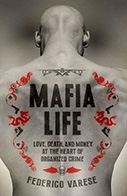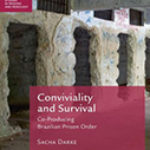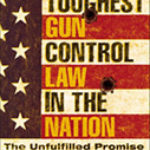Mafia Life: Love, Death, and Money at the Heart of Organized Crime

Author: Frederico Varese
Publisher: New York: Oxford University Press, 2018. 279p.
Reviewer: Jay S. Albanese | March 2020
Written by an author with decades of prior writing and research on organized crime, Mafia Life is designed to synthesize his work into an overarching narrative that links mafia groups of different times, sizes, and world regions into a common context for understanding.
The book’s narrative is just more than 200 pages and written in an unusual breakdown of topics. Divided into 9 chapters, the titles proceed from birth, work, management, money, love, self-image, politics, death, plus a concluding “post-mortem.” The narrative is written free of footnotes and citations, leaving the last 40 pages of the book for the author’s notes about the sources used.
Each chapter begins with a story, usually involving an extended interview conducted by the well-travelled author with someone possessing firsthand knowledge of mafia operations in that locale. Varese has been to many places, so these opening sections to each chapter move from England, Russia, Italy, Macau, Hong Kong, with many other locations mentioned in the discussion including the US, Greece, Burma, China and others.
Frederico Varese has written both journalistic articles and research studies over the course of his career, so his ability to tell a story is a cut above most other academics. His primary research method is interviews with principal actors (mafiosi of various kinds) and those directly affected by them (e.g., government officials, activists, journalists, NGOs, businesspersons). Of course, the author also relies on government reports, court cases, archival data, and the work of other journalists and researchers.
The difficulty in writing a book that moves from a single case in a different venue in each chapter is moving from the anecdotal to more general conclusions. At times, generalizations drawn are based on a very small number of selected sources from a specific time period. This is an issue in all research involving interviews, although large numbers of interviews around a theme, event, or jurisdiction make generalizations easier to locate and justify.
Varese defines “mafia” as “a collection of ‘gangs’ controlling a territory and subscribing to the same rules of behavior.” (p.7). He discusses many groups from the Vory in Russia, Triads in Hong Kong, Yakuza in Japan, Mafiosi in Italy and the US, among many gangs of different national, ethnic, and organizational types. As the book’s subtitle suggests, it is illicit profit that distinguishes the motives of mafia groups from other kinds of groups, such as terrorists. Mafia groups are further distinguished by their desire to control territory, and establish some kind of monopoly in a local area. So in addition to providing illicit goods or services, these groups have territorial ambitions. These ambitions lead to the obvious comparisons of mafia groups to governments, which also try to raise money, secure public support or obedience, and establish authority over a particular jurisdiction. It is easy to say that the difference is that mafias achieve these objectives by intimidation, whereas governments accomplish them by consent, but there are many global examples in both the ancient and modern world that provide striking similarities in the coercive methods used by both mafias and governments.
In addition to the distinct territorial ambition of mafia groups, Varese also focuses on their “efforts to develop norms of behavior that are shared across Families,” which distinguish them from other kinds of organized crime (p.7). The author includes two appendices, one of which includes a “Syntopic Table of Mafia Rules,” comparing the shared rules within five different kinds of mafia groups (i.e., Sicilian Mafia, Italian-American Mafia, Yakuza, Triads, and Vory of both older and modern times). These kinds of norms can be difficult to defend because there are so many examples of violations of these rules in practice. It is difficult to see them as being much more than platitudes, rather than binding agreements of any real consequence. For example, the list of shared rules for the Italian American mafia includes: “don’t disobey or cause a nuisance to superiors, don’t fight with fellow members or disrupt the harmony of the gang, don’t embezzle gang funds, never violate the wife or children of another member, never reveal secrets of the organization, do not appeal to the police or law, no personal involvement with narcotics” (pp. 217-19). Multiple accounts and court records of the mafia in the U.S. show frequent and repeated violations of these supposed rules over time.
“What fascinates and scares me is the ability of these organizations to produce a kinds of social order out of fear and injustice.” (p.10). As the author also notes, these goals of mafia groups are precisely the same ones of totalitarian governments, which is why mafia groups uniformly oppose authoritarian regimes, because they leave less room for the illicit activity of mafia groups. Ironically, mafia group interest in controlling territory pushes them to support democracies, because there is more room for them to corrupt and control illicit markets in democracies, which are more susceptible to infiltration, corruption, and control.
The narrative jumps around the world and across time to explain the nature of criminal groups across the world. Those without a background in understanding organized crime might have difficulty following the comparisons, but the author’s intent is to highlight similarities among groups in very different cultures, countries, and circumstances. There is great detail is some of the descriptions of the nature of mafia murders, but major themes include how mafia groups work to look legitimate, and the importance of effective law enforcement and an engaged civil society in challenging the power and influence of criminal groups of all types.
Mafia Life is a unique look at criminal groups across the world, using interviews in different world locations as a launching pad for a reasoned inquiry into their similarities across time, culture and region.
Jay S. Albanese Professor, Wilder School of Government & Public Affairs Virginia Commonwealth University www.jayalbanese.com


